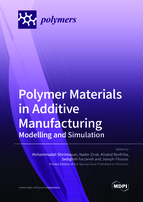Polymer Materials in Additive Manufacturing: Modelling and Simulation
A special issue of Polymers (ISSN 2073-4360). This special issue belongs to the section "Polymer Physics and Theory".
Deadline for manuscript submissions: closed (5 October 2022) | Viewed by 28813
Special Issue Editors
Interests: polymers and composites; polymer processing; mechanical properties; solid mechanics; fracture mechanics; material characterization; additive manufacturing
Special Issues, Collections and Topics in MDPI journals
Interests: polymers and composites; polymer processing; mechanical properties; material characterization; additive manufacturing; biopolymers
Interests: manufacturing engineering; industrial engineering; engineering education; algorithms; educational management
Special Issues, Collections and Topics in MDPI journals
Interests: polymers and composites; polymer processing; material characterization; biodegradable polymers
Special Issues, Collections and Topics in MDPI journals
Interests: polymers and composites; polymer processing; mechanical properties; solid mechanics; fracture mechanics; material characterization; additive manufacturing
Special Issues, Collections and Topics in MDPI journals
Special Issue Information
Dear Colleagues,
Additive manufacturing (AM) extensively has been at the center of attention of studies and industry. The AM process involves gradual build-up in layers, and capability in the fabrication of complex shapes with low cost. Advances in the processing of polymers and polymer composites with this method are in the domain of this journal which can provide a vital resource for anyone involved in additive manufacturing. This Special Issue will cover but is not limited to original reviews and research articles dedicated to:
- AM processes of manufacturing and materials;
- Process–microstructure/morphology–properties relationships;
- Optimization of process parameters;
- Mechanical properties of fabricated parts;
- Modeling and simulation.
Dr. Mohammadali Shirinbayan
Dr. Nader Zirak
Dr. Khaled Benfriha
Dr. Sedigheh Farzaneh
Dr. Joseph Fitoussi
Guest Editors
Manuscript Submission Information
Manuscripts should be submitted online at www.mdpi.com by registering and logging in to this website. Once you are registered, click here to go to the submission form. Manuscripts can be submitted until the deadline. All submissions that pass pre-check are peer-reviewed. Accepted papers will be published continuously in the journal (as soon as accepted) and will be listed together on the special issue website. Research articles, review articles as well as short communications are invited. For planned papers, a title and short abstract (about 100 words) can be sent to the Editorial Office for announcement on this website.
Submitted manuscripts should not have been published previously, nor be under consideration for publication elsewhere (except conference proceedings papers). All manuscripts are thoroughly refereed through a single-blind peer-review process. A guide for authors and other relevant information for submission of manuscripts is available on the Instructions for Authors page. Polymers is an international peer-reviewed open access semimonthly journal published by MDPI.
Please visit the Instructions for Authors page before submitting a manuscript. The Article Processing Charge (APC) for publication in this open access journal is 2700 CHF (Swiss Francs). Submitted papers should be well formatted and use good English. Authors may use MDPI's English editing service prior to publication or during author revisions.
Keywords
- additive manufacturing
- polymers
- polymer composites











